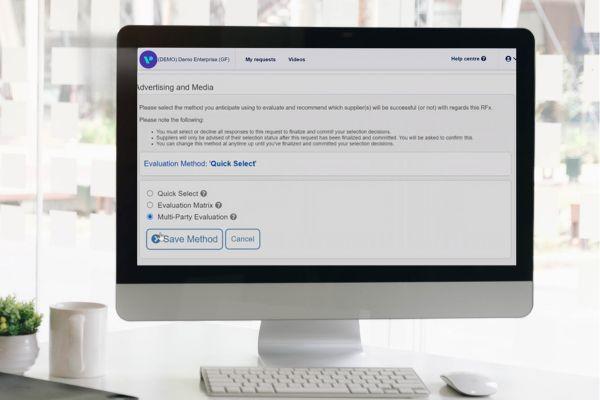The benefits of using Multi-Party Evaluation in procurement
By Michelle Stockdale, Procurement Partner
In the context of Queensland Local Government, Multi-Party Evaluation (MPE) is an assessment process involving multiple stakeholders, such as government agencies, community groups, and independent evaluators. This collaborative approach aims to ensure a comprehensive and balanced evaluation by incorporating diverse perspectives and expertise. Did you know MPE is available to all Queensland councils through Local Buy’s fully funded Procurement Technology, free of charge? Find out more by emailing Michelle at Local Buy.
MPE in Local Government procurement offers several benefits:
- Enhanced Transparency and Accountability: Involving multiple parties in the evaluation process ensures that decisions are made transparently and that all actions are accountable. This reduces the risk of bias and corruption.
- Diverse Perspectives: Different evaluators bring varied expertise and viewpoints, leading to more comprehensive assessments of bids. This diversity helps in identifying the best value for money and the most suitable suppliers.
- Improved Decision-Making: With multiple evaluators, the decision-making process is more robust. It allows for thorough scrutiny of proposals, ensuring that all aspects, including economic, environmental, and social impacts, are considered.
- Risk Mitigation: MPE helps in identifying potential risks early in the procurement process. This collaborative approach ensures that risks are managed effectively, leading to more successful project outcomes.
- Compliance with Legislation: It ensures adherence to the Queensland Local Government Act sound contracting principles which include value for money, open and effective competition and ethical behaviour and fair dealing. These benefits collectively contribute to more effective and efficient procurement processes, ultimately delivering better outcomes for the community.
It’s important to note however, that Queensland councils frequently encounter challenges in the evaluation process, particularly when involving multiple personnel, such as:
- Coordination and Communication: Ensuring all parties are on the same page can be difficult, especially with varying schedules, priorities, and communication styles.
- Resource Allocation: Limited resources, such as time, budget, and personnel, can hinder the evaluation process.
- Data Integration: Combining data from different sources and ensuring its accuracy and consistency can be challenging.
- Stakeholder Engagement: Engaging all relevant stakeholders and maintaining their interest and cooperation throughout the evaluation can be tough.
- Conflict of Interest: Different parties may have conflicting interests or perspectives, which can affect the objectivity and outcomes of the evaluation.
VendorPanel’s MPE tool, designed to streamline and enhance procurement evaluation processes, can help mitigate some of these risks. Did you know MPE is available to all Queensland councils through Local Buy’s fully funded Procurement Technology, free of charge?
MPE allows multiple people to take part in the same evaluation. The evaluation is managed by the buyer, who can invite participants via email. These participants do not need a VendorPanel account to conduct their evaluation. The buyer can allocate all or part of the evaluation criteria to each evaluator. For example, a consultant specialising in a particular field such as Engineering, may only be assigned one criteria to evaluate specific to their field of expertise. Another example of this application is assigning a Work Health and Safety Officer exclusively to evaluate the WH&S criteria.
A great feature in MPE is the option for buyers to select what documents they would like to make available to evaluators.
When establishing MPE, buyers can create their own criteria or utilise an existing criteria template. A minimum of 2 and maximum of 25 criteria can be set and weightings are fully customisable.
VendorPanel’s MPE tool has the following three options available when evaluating pricing.
|
Independent Factor (recommended) |
This is the recommended pathway for price evaluations, treating price independently of your criteria, in order to provide insights into the value for money of responses. Using this method, pricing is excluded from evaluations until the results step, where the evaluation scores are then compared against the pricing submitted, to create a Value for Money graph. This holds response Scores on the X axis, and Pricing on the Y axis. |
|
Price Auto-scored |
Buyers are also able to choose to have prices evaluated automatically, in line with their other manual evaluations. Buyers choose the weighting given to the price and are given the opportunity to confirm/amend the given price on the Prices step. The Price score is then factored alongside the other evaluation criteria, to receive a single, whole score for the response. |
|
Price Manual |
Buyers are able to choose to disable price evaluations in order to allow you to include price as a normal criteria, which is to be manually scored by your evaluators. |
The invited evaluators will score each supplier response based on criteria set by the buyer. A consensus decision is then reached on the scores for each response before a decision is made on the successful supplier. Buyers can generate a draft PDF report at any stage of the MPE process with a final version available to download once the evaluation has been completed.
By addressing challenges, promoting collaboration and utilising VendorPanel’s MPE tool, procurement officers can conduct more effective and comprehensive evaluations.
Like to learn more? Visit the VendorPanel website or contact Michelle Stockdale – Local Buy Technology Procurement Partner, for more information.

